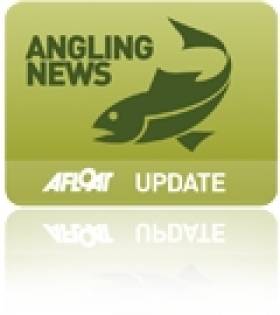Displaying items by tag: Shannon
Jimmy Tyrrell – An Arklow Maritime Legend
#arklow legend – We are fortunate in this country to have people who are dedicated to the marine sphere and who give freely and willingly of their time and efforts in pursuit of their belief that maritime matters really should matter to the national community.
Jimmy Tyrell from Arklow is such a man. I have known and respected him through his work for the lifeboats for many years.
The RNLI has a proud history of over 190 years and the port of Arklow in County Wicklow, a town founded by the Vikings in the 9th century, lays claim to being the first lifeboat station established in Ireland, back in 1826. Jimmy Tyrrell has led lifeboat operations there for 46 years. His family is legendary in maritime matters.
Twenty-seven years ago Jimmy made a decision. The RNLI named its different classes of boat designs after rivers, but had never used the name of an Irish river. Jimmy was determined to change that and being a determined man, he achieved his goal. So when the new Shannon Class was born, the most modern vessel in the RNLI fleet and the first into Ireland arrived at the Lough Swilly Station at Buncrana in County Donegal, Jimmy was there to see it.
It was a great day for Jimmy, well-deserved and he describes his feeling as he saw the boat arrive on this edition of THIS ISLAND NATION.
When Jimmy retired from RNLI duties in Arklow another member of that great maritime family stood up to take over from him and continue the family association, John Tyrrell, who is now Lifeboat Operations Manager there.
The new Shannon lifeboat at Lough Swilly cost €2.4m and was designed by a Derry man who works for the RNLI at its Poole headquarters. It uses twin waterjets instead of propellers, giving it more manoeuvrability and the ability to operate in shallow waters. The man who designed it is Peter Eyre and he was once saved by the lifeboat service when he got into difficulty on the water, the story of which he tells also on the current edition of THIS ISLAND NATION.
When the RNLI describes a boat as "all-weather..." they mean it, the service always responds to calls for help, even in the worst of sea conditions, so the crews deserve the best boats. The Shannon has a top speed of 25 knots, a range of 250 nautical miles and a unique hull to minimise slamming of the boat in heavy seas, with shock-absorbing seats to protect the crew from impact when powering through the waves. The Lough Swilly lifeboat has been largely funded through a legacy from Derek Jim Bullivant of Bewdley, Worcestershire, in the UK who died in September of 2011.and is named Derek Bullivant. Coxswain, Mark Bennett, commands it and was welcomed by a huge crowd when he and his crew brought the boat from Poole to Buncrana. He tells us how it was an emotional day for him.
BASS BAN
This edition of Ireland's niche maritime programme also has an interesting story about supermarket advertising which can mislead purchasers into thinking they are buying Irish bass when it is illegal to catch them for commercial purposes in Irish waters, where such fishing is banned. So why are the public misled by advertising which says "Irish produced bass" when they come from fish farms abroad?
David Stanton, the Fine Gael TD for Cork East interested – and somewhat pleasantly surprised me – by making an issue of the lack of Government and State attention to the marine sphere. It's not often, I put to him, that a politician is heard to draw attention to maritime matters. He has a good point -that there is no single, central point in the State system, no 'one-stop-shop,' where all maritime enquiries can be dealt with, so anyone proposing a project can be sent from one section of the State services to another so many times they could meet themselves coming back. He is worth listening to and I'll be looking forward to hearing how the self-imposed mission he has declared, to highlight maritime affairs at Government level, gets on.
The island communities join the programme with a regular report, in which we hear why €60,000 a year, not a huge sum of money, is vital to education on the islands.
A lot then, about maritime matters which you can hear THIS ISLAND NATION by clicking on the programme icon above
Your comments are welcome below.
First RNLI Shannon Class Lifeboat in Ireland to Arrive into Lough Swilly, County Donegal
#rnli – Lifeboat crew from Lough Swilly RNLI are currently onboard the station's new €2.4 million Shannon class lifeboat and en route to its permanent home in Donegal from the charity's headquarters in Poole. As Afloat reported earlier, he new lifeboat is the first of its class to be put on service in Ireland and the first to be named after an Irish river, the previous classes are all called after UK rivers.
The lifeboat crew are being accompanied on the journey by RNLI staff coxswain Martin Philips, who is using the long passage home as an opportunity to continue with the training programme for the state of the art lifeboat. On the last leg of the passage the crew will be joined by RNLI Divisional Operations Manager Darren Byers but the honour of taking the lifeboat into Lough Swilly will fall to the station Coxswain, Mark Barnett. The crew got a preview of the boat in build last November.
The station is hoping for a large turnout at the Buncrana pier as the new lifeboat arrives into the harbour at noon on Friday 10 April, to take up residence on the Donegal coastline. The lifeboat is named Derek Bullivant and has been largely funded through a legacy from Mr Bullivant who hailed from Bewdley, Worcestershire, UK and who passed away in September 2011.
The Shannon is the latest class of all-weather lifeboat to join the RNLI fleet and the first to be propelled by waterjets instead of traditional propellers, making it the most agile and manoeuvrable all-weather lifeboat in the fleet. Waterjets allow the vessel to operate in shallow waters and be intentionally beached.
The new lifeboat was developed to operate in the worst of sea conditions and is self-righting, automatically turning the right side up in the event of a capsize. Its unique hull is designed to minimise slamming of the boat in heavy seas and the shock-absorbing seats further protect the crew from impact when powering through the waves. The lifeboat has a top speed of 25 knots and a range of 250 nautical miles, which makes it ideal for offshore searches and rescues in calm and rough seas.
Commenting from onboard the Shannon lifeboat, Lough Swilly RNLI Coxswain Mark Barnett said, 'This day has been a long time coming for our lifeboat station and it is one that is very emotional for all of us. The arrival of a new lifeboat is a huge investment in the community by the RNLI. It's not just a financial investment but it is also an investment in our lifeboat crew, the people who live here and the people who use the waters around our station, whether locally based or just passing through.
This will be its home for many years to come and it will be launched on countless rescues and save many lives. We would also like to express our gratitude to the late Mr Derek Bullivant, whose name is proudly displayed on our lifeboat and whose generosity made this possible.'
Once the lifeboat is on station, training will continue for the remaining volunteer lifeboat crew at Lough Swilly RNLI before the lifeboat is officially put on service and the previous one is retired into the relief fleet.
#Angling - Inland Fisheries Ireland (IFI) is seeking submissions from interested parties to update and amend existing Trout Bye-laws currently in operation in the Shannon River Basin District.
It is noted that the existing bye-laws in the Shannon catchment are for certain angling waters ambiguous and for others outdated.
IFI intends requesting the Minister for Agriculture, Food and the Marine to replace the existing bye-laws with more updated regulations that will better enable the management of these waters in a sustainable manner.
The key bye-laws to be replaced or restated and amended are numbers 787 (Lough Ree, 2003), 790 (Lough Sheelin, 2003) and 817 (River Shannon No 8 District, 2007).
The areas being considered for review are:
- To set the bag limit for wild brown trout on Loughs Owel, Ree, Derg and Sheelin to three fish per angler per day.
- To set the close season for Lough Owel, Ennell, Derravaragh and Ree from 1 October till the last day of February inclusive.
- To set the close season for Lough Derg from 1 October till 16 March inclusive.
- To amend the minimum size limits or introduce a bracket size of fish that can be taken by anglers on Loughs Owel, Ennell, Ree, Derg and Sheelin.
- Other amendments as required in line with best practice and following the submissions received.
IFI may, as part of the process, arrange a public consultation meeting if deemed necessary, but all submissions must be received in writing and will be published on the IFI website at www.fisheriesireland.ie.
Submissions may be sent by post to the Director, Inland Fisheries Ireland, Ashbourne Business Park, Dock Road, Limerick or by email to [email protected].
The closing date for receipt of submissions is at 5pm on Friday 17 April 2015.
Man Rescued From Shannon In 'Dangerous Conditions'
#Rescue - Specialist water rescue firefighters entered the Shannon in Limerick city last night (Monday 15 December) to rescue a man who entered the river.
As The Irish Times reports, the two firefighters braved "very dangerous conditions" to retrieve the man from the water at Barrington's Hospital on George's Quay.
IWAI & The Waterways of Ireland – New Book By Brian Cassells
#inlandwaterways – When English writer LTC Rolt made a round trip from the Shannon to Dublin in 1946, traversing the Grand and Royal Canals, he was considered an eccentric. In the 1940s commercial traffic on the canals and rivers of Ireland had dwindled to almost nothing. Rolt's notion that these waterways could be a source of joy to leisure boaters was considered pure whimsy. But it was the book Rolt published after this trip, Green and Silver, that was to act as inspiration for the formation of the Inland Waterways Association of Ireland (IWAI) in 1954.
There were other catalysts, too, that fired up the Association. The swing bridge at Athlone was to be replaced with a fixed span. The Royal Canal had already fallen into disrepair and was closed to navigation. Dublin Corporation proposed to lay a sewer along the Grand Canal and fill it in to make a road. The IWAI determined to oppose the authorities in their attempts to impede and close the network of waterways.
IWAI and the Waterways of Ireland is a celebration of sixty years of the Association doing just that. It begins with a rattle through the waterways themselves – the many rivers, lakes and canals. A short history of the IWAI follows, interesting as much for the names listed at the inaugural meeting as for what was achieved. Two of these were Colonel Harry Rice, retired from the British Army, and Sean McBride, dedicated Republican, politician and Nobel prize winner. Brian Cassells, writer and compiler of this book, comments 'I smile when I think of a dedicated Republican being best friends with a retired Colonel of the British Army.'
This fact says much about the compelling charm of boating in Ireland – it is a great social leveller. The portraits of people include George O'Brien Kennedy, boat designer; Syd Shine, showband leader; Rosemary Furlong, RNLI fundraiser; Jim McGarry, skipper. A diversity of people who were passionate about the rivers and canals, the boats and buildings.
The backbone of the IWAI remains the branches, and these are covered in full. It is the reasons for their creation, and the progress made, that make these descriptions come alive. How local opinion in Kenagh on the Royal Canal was certain it would never be re-opened (it was). Volunteers working on the Lagan Navigation clocking up 11,000 hours to restore Ireland's only flight of four locks. Coalisland branch members who possessed not a boat between them, dedicated to saving their canalside heritage.
The IWAI still has a campaigning role. There are notable successes in the book, given their own special pages – Ram's Island on Lough Neagh, the Royal Canal, and the Boyne Navigation. There is hope for the restoration of the Ulster Canal.
Brian Cassells has put together a book of immense charm, lusciously produced, rich in photographs. There is some repetition of facts, perhaps inevitable in a book with many different contributors. Nonetheless it is a valuable record of, and insight into, an organisation which has been instrumental in safeguarding a network of waterways that is among the most beautiful in Europe.
Walking the Shannon Blueway
#shannonblueway – Leitrim, Roscommon and Cavan have many kilometres of walking trails, looped, linear, long and short distance, all linked by one thing – the waterways. There are over 100km of water trails radiating from Carrick-on-Shannon which link these existing walking trails and to which Waterways Ireland has added National Loop Walking Trails along the Lough Allen Canal in partnership with Failte Ireland and Leitrim County Council.
There are three loops between Battlebridge and Drumhauver;
Battlebridge Drumleague loop 5km
Battlebridge Drumhauver loop 9km
Drumleague Drumhauver loop 4km
The Blueway builds on the huge potential provided by the existing waterway infrastructure. The potential is enhanced by the geography of the area offering hugely attractive rural towns and villages, such as Drumshanbo, Leitrim Village, Carrick-on-Shannon, Dromod and many others, closely located along the waterway that provide natural achievable looped trails, three heritage trails and access to the long distance routes of the Miners Way and the Leitrim Way. They are immensely attractive for short duration activity breaks.
The Blueway will enhance the choice available for visitor experience with the option of coming for an extended period to cruise the waterway or coming for a half day canoeing, cycling or walking break or any combination of activities. The new Shannon Blueway will offer a wide range of affordable pursuits in a safe family friendly environment.
The existing providers of commercial and recreation services in the region already recognise the significant opportunity the Shannon Blueway presents. Three new providers have opened in recent months.
Shannon Blueway Launched with a Splash in Leitrim
#blueway – Minister Heather Humphreys TD, and actor & producer Carrie Crowley joined with over 300 walkers and paddlers to open the Shannon Blueway today in Drumshanbo, Co Leitrim.
As previously reported on Afloat.ie, the Shannon Blueway runs from Drumshanbo through Battlebridge and Leitrim Village to Carrick on Shannon. It includes 16.5km of water trail and over 10km of walking routes in three loops. The Shannon Blueway provides a range of recreational leisure activities such as walking, cycling, canoeing, fishing and cruising all linked by the waterways to local towns and villages.
Minister Heather Humphrey's stated "I am delighted to be launching this project here in Leitrim today. The Shannon Blueway has the potential to have a very positive impact on jobs and the regional economy. The Mayo Greenway, which is now in its 4th year of operation, has seen a jump in visitor numbers from 80,000 in 2011 to 300,000 in 2014. That means an extra €5 million was brought into the region. With the market for off road adventure tourism is growing here in Ireland and internationally, Leitrim is in a prime position to benefit from this trend.
The launch of the Blueway will allow local businesses can capitalise on an increase in demand for transport, equipment hire, accommodation and entertainment. I would like to commend Waterways Ireland for this initiative, which I have no doubt will have a very position impact on the region."
Carrie Crowley said "as a self-confessed blow-in to the area, the Shannon, the wonderful countryside and Leitrim people have provided me with a tranquil and inspirational place to work and home away from home .The only problem is, now our secret is out!"
The Shannon Blueway is the first of its kind in Ireland where a myriad of recreational activities have been developed and bundled together as a single or multiple visitor experience and tourism proposition. Waterways Ireland has, using the wonderful waterway assets, developed and built a canoe trail from Drumshanbo through Battlebridge and Leitrim Village to Carrick on Shannon. It has also developed a series of looped walks adjacent to the Lough Allen Canal with plans to expand those walks to Drumshanbo and Carrick on Shannon. At the same time Waterways Ireland is also developing a canoe trail from Leitrim Village along the 63km of the Shannon Erne Waterway with a walking and cycling trail also at an advanced stage of planning.
The Shannon Blueway is being delivered by Waterways Ireland in partnership of the National Trails Office, Canoeing Ireland, Leitrim County Council, Leitrim Tourism and Fáilte Ireland.

Minister Heather Humphreys TD, and WI Chief Executive Dawn Livingstone
Chief Executive Dawn Livingstone confirmed that partnership was the key to delivering the Shannon Blueway "Waterways Ireland has invested significantly in creating world beating facilities and services on the Shannon Navigation. Through our partnership with the National Trails Office, Canoeing Ireland, Leitrim Tourism and Leitrim County Council an outstanding multi-activity product has been built in the Shannon Blueway which is now being packaged by clubs and communities for their recreational activities and companies and organisations for domestic and international tourists. Partnership is key to delivering the future of the Shannon Blueway further into Leitrim, and indeed into Roscommon, Longford and Cavan."
The wider Shannon Blueway of which the Drumshanbo to Carrick on Shannon section is part, is at the heart of access to 100km of paddling area, 6 looped walks: 3 of which are on the canal towpath, two long distance walks and three heritage trails. The Shannon Blueway will ultimately provide access to 14 towns and services with each access point and town within an hours' paddling time.
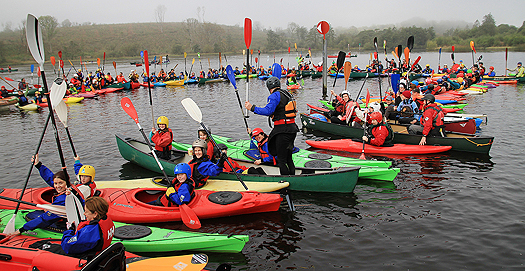
300 paddlers joined the ShannonBlueway launch
Waterways Ireland and Leitrim Co Co will shortly be examining the possibility of providing a connection from the jetties at Acres Lake to the canal towpaths and also to complete the walking/cycling connection to Carrick-on-Shannon, and up the Shannon-Erne Waterway.
President Michael D Higgins has been in Limerick this week in honour of its status as Ireland's City of Culture 2014. In addition to other events, a highlight was his award of the Freedom of Limerick, something very special to him as he was born in the Shannonside port.
Ireland's Head of State is keenly aware of the Shannon and Limerick's rich maritime heritage, and he and his party spent almost an hour visiting the "Naumachia in the Cathedral", the exhibition in St Mary's Cathedral of the CityOne sailing dinghies built by trainees with the Ilen Boatbuilding School in the city.
The Ilen Boatbuilding School has several significant cultural aspects, as it was brought into being by Limerick designer Gary MacMahon and Brother Anthony Keane of Glenstal Abbey initially to teach boat-building skills by restoring the 1926-built 56ft ketch Ilen, which was designed by noted Shannon Estuary ocean voyager and adventurer Conor O'Brien.
But then as the work of the school developed, it took on the project of also building 23ft boats of the traditional Shannon gandelow type, specialized craft which evolved over the centuries to deal with the challenges of using the shallow and muddy waters of the Shannon Estuary with its exceptional tidal range.
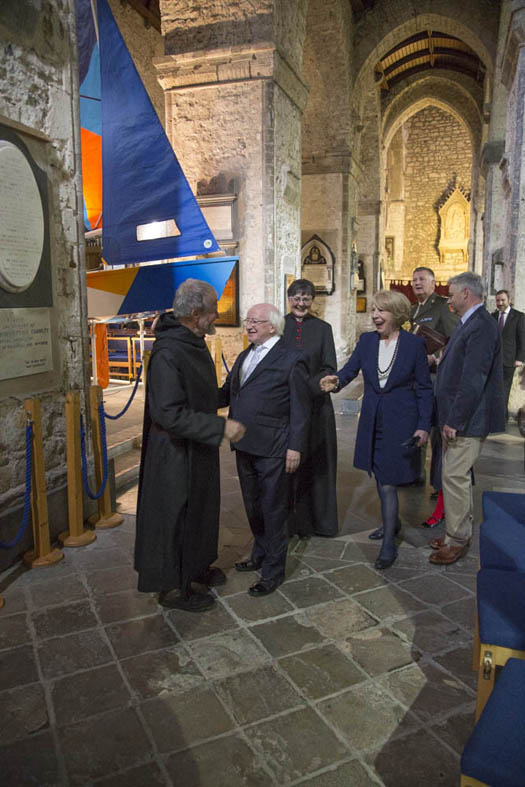
The President of Ireland is welcomed to the Naumachia in the Cathedral by Brother Anthony Keane of Glenstal Abbey. Also foreground are the Dean of Limerick the Very Reverend Sandra Bragnell, Mrs Sabina Higgins, and Gary MacMahon of Ilen Boatbuilding School.
It was the first time any new gandelows had been built in well over thirty years. This project was then further developed to build the CityOne Sailing Dinghies specifically for Limerick use, the unique design of these boats being drawn by naval architect Theo Rye to a detailed Limerick specification. With the new dinghies planned for completion at the height of Limerick's year as City of Culture, a CityOne International Graphic Arts Competition was also launched to create innovative ideas for the colour layouts on the sails and the hulls of the boats. It attracted 61 entries worldwide, and the four selected designs were from graphic artists in Kenya, Ireland Portugal and Texas.

Participants in the Ilen School at the Cathedral included (left to right) Robert Smalle. Tony Broe, Liam O'Donoghue, James Madigan (Ilen School Instructor), Michael Grimes and Gary Wilmott.
It was the CityOne dinghies with their striking colour schemes which formed the centrepiece of the Naumachia in the Cathedral. But there were other exhibits linked to the many aspects of the Ilen School's work too, and in addition to meeting the boatbuilders and crews that sail the CityOnes, the President also met the "Gandelow Gang", who are drawn from the Limerick area both to make up the building teams for gandelows and CityOnes alike, and to row the gandelows in competition and traditional boat gatherings at home and abroad.
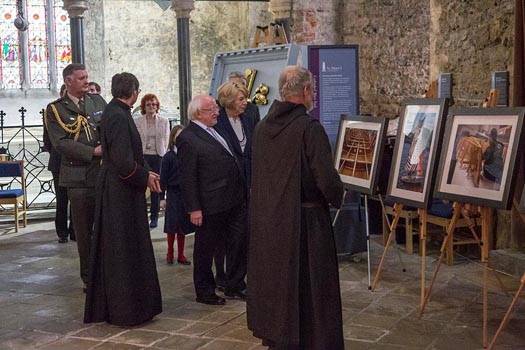
The Presidential party inspect the exhibits detailing the work of the Ilen School
In concluding his speech, the President summed up the mood of the day:
"I very much want to thank everyone involved in staging this exhibition here in this magnificent 12th Century building. What a great tribute it is to those who put all the original stones in place, that there is something new of the human spirit and craft being exhibited here. These boat builders, they are consummate craftsmen.
The international design dimension to the CityOne project is to be highly commended, and it is such a pleasure to be here with you today. I am delighted that the Ilen School project is part of the Limerick City of Culture. Isn't it wonderful that these skills are being passed down and developed, so that more and more people can take part, and for the community to see such inspiring craft?"
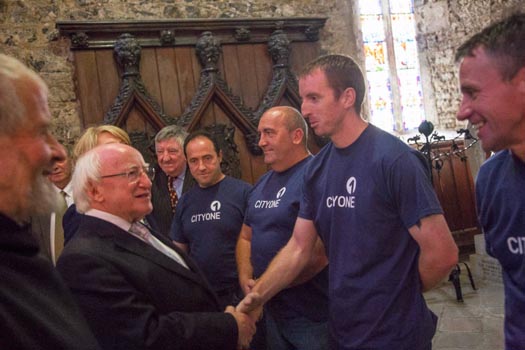
The President meets members of the Gandelow Gang and the Ilen Boatbuilding School including (left to right) James Madigan, Michael Grimes, Gary Wilmott and Tony Broe.
Limerick 'CityOne' Sailing Dinghies Unite The Shannonside Capital As One City
Minister for Finance Michael Noonan, the senior TD in Limerick, yesterday morning launched a "Naumachia in the Cathedral" with the boats built in the visionary CityOne project in the Shannonside city. On Monday afternoon, President Michael D Higgins will also see the boats in St Mary's Cathedral, and meet those involved. It has all become a key part of the Limerick City of Culture 2014, but as W M Nixon reveals, the success of the CityOne dinghies is just part of a remarkable continuing series of creative boatbuilding programmes.
Gary MacMahon of Limerick has a remarkable talent for publicity. Yet he doesn't court it personally. On the contrary, he tends to keep to one side when events he has brought about are in full swing. But because he keeps coming up with visionary ideas which no-one else had thought of before, and also has the ability, patience and quietly persuasive powers to bring them to fruition in the fullness of what is sometimes a very long time, inevitably the novel brilliance of what he has achieved hits the attention button big time.
By profession, he is a graphic and website designer running Copper Reed Studios in Limerick city with his wife Michelle and a staff of six. But like all Limerick people, he has a passion for seeing his home town doing better, improving its image, and making itself a more enjoyable place. And when that passion is allied to the MacMahon powers of vision and dreaming the dream, the results can be extraordinary.
He first came to national attention within Ireland's maritime community back in 1998, when he inspired and organized the return of Conor O'Brien's ketch Ilen from the Falkland Islands. In 1923-25, the magnificent voyage by Conor O'Brien of Foynes on the Shannon Estuary round the world in the 42ft ketch Saoirse – which he'd designed himself to be built in Baltimore – had in turn resulted the Falkland Islanders being so impressed by Saoirse when she sailed in to their lonely archipelago after rounding Cape Horn, that they ordered a larger sister sister-ship to be built for their inter-island service vessel.
This resulted in the cargo and passenger carrying 56ft ketch Ilen, designed by O'Brien (an architect by training though a writer by vocation)) and Tom Moynihan, who'd built Saoirse and now built the new vessel in Baltimore in 1926. The ketch finished, the difficulty was getting her to her new owners in the Falklands. In the end, to get insurance for the delivery trip in which he would be in command, O'Brien had to register the Ilen as a yacht, and he sailed her out to the Falklands as he'd sailed Saoirse, under the burgee of the Royal Irish Yacht Club, with Ilen crewed by two islanders from Cape Clear.
Meanwhile Saoirse, having gone through a few mostly happy ownerships, was wrecked after being driven from her moorings in a hurricane in Jamaica in 1979. The gallant Ilen, still working away in the Falklands and now fitted with a larger auxiliary engine, continued to give good service. But by the 1990s the word was that she was no longer in use, having been laid up on moorings at Port Stanley, reportedly in basically quite good order but inevitably suffering from the region's severe weather.
Ilen was now unique as the only surviving O'Brien seagoing design. So one crisp morning in the winter of 1997-98, Gary MacMahon suddenly found himself possessed by the notion that the Ilen should be brought back to Limerick just as soon as possible to act as a re-birth symbol for the revitalization of a riverine city and its mighty Shannon Estuary, all of which were going through turmoil with industrial decline and the moving of Limerick port's operations downstream to Foynes and other deep-water pier locations.

The Conor O'Brien-designed, Baltimore-built 56ft ketch Ilen back in Irish waters in 1998 for the first time since 1927. She is seen here in Dublin Bay before being sailed to Oldcourt on the Ilen River in West Cork. Photo: W M Nixon
Quite how he managed it all we can only guess, but within what seemed like a matter of days he found himself in Port Stanley with the deal done to buy the Ilen, and in the early Spring of 1998 she was unloaded from a ship in Dublin docks. Now what? Clearly, the old ketch needed massive restoration work in order to make her fit for any regular seagoing service under sail with trainees or passengers on board. But with her size and the special demands of her age and construction, there was only one place in Ireland where the work could be confidently undertaken, the Hegarty boatyard at Oldcourt on the River Ilen in West Cork just a few miles upstream from Baltimore where the ketch had been built 72 years earlier.
So in the summer of 1998 she was commissioned in Dublin Bay, and sailed under the command of Paddy Barry to Baltimore and a rapturous welcome. Then in time she was hauled into and old stone waterfront shed in Oldcourt, and here she has been ever since while a continuing programme of restoration has become, as is so often the case with old well-used boats, a virtual re-build, but done in such a way that the shape of the original vessel is exactly replicated, and at any time in going into the shed you are in fact looking at the Ilen.
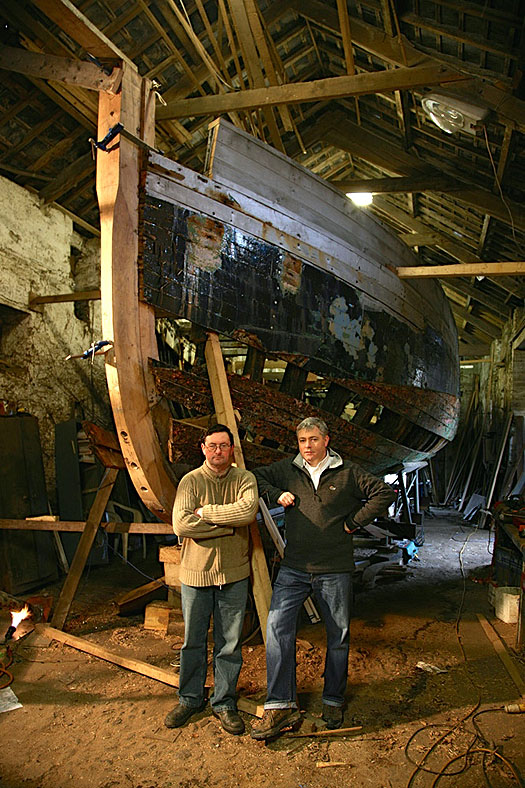
Work in progress – and it's still in progress. Boatbuilder Liam Hegarty (left) and Gary MacMahon at an early stage of the Ilen restoration, when the stem had been replaced.

Replacing frames in Ilen at Oldcourt. Once the frames are all located, planks can also be replaced where necessary without any loss of the vessel's shape.
To do this, trainee boat-building schemes were implemented, with a strong Limerick emphasis in the recruiting. It soon acquired an international element with an input from many renowned traditional boatbuilders, until five years ago it was given a more formal structure with the establishment of the AK Ilen Boatbuilding School. The work continued in Oldcourt, but they also had bright new premises in Limerick where deckhouses and so forth for the Ilen could be built. But it was very quickly realized that a building programme for smaller boats in the Limerick premises would also provide a rewarding interest for people from all sorts of backgrounds who could find fulfillment – often unexpected fulfillment and mental serenity – in working with wood and building boats.
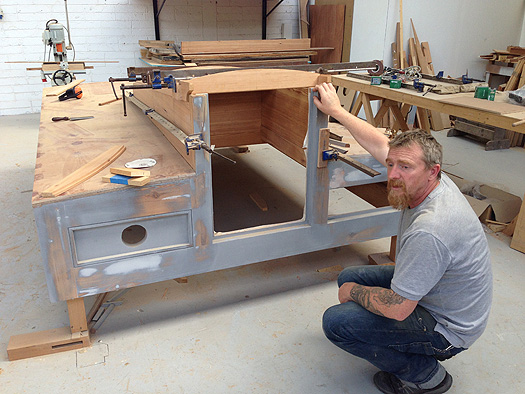
Ship's carpenter JimMcInerney with the new deckhouse for Ilen in the boat-building school's Limerick premises
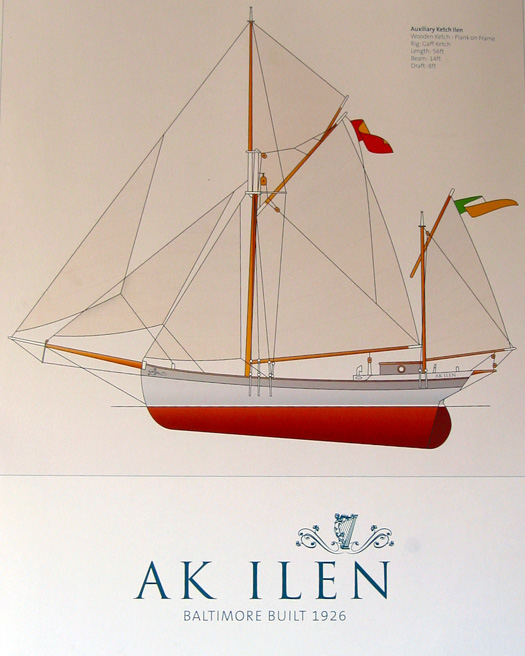
The objective – Ilen as she will look when restored. Her underwater profile was shaped to facilitate landing people and goods at drying quays, or even directly onto a beach.
Initially they used a simple dory design, but then came a typical MacMahon stroke of genius. There's a type of boat unique to the Shannon Estuary known as the gandelow. The classic gandelow is around 23ft long, and while above the water she may look like a hefty version of a typical Irish clinker-built lakeboat as beloved by the mayfly fishermen, underneath she is completely flat-bottomed in order to have minimum draft, and to be capable of slithering across the gooey mud with which the 60-mile long Shannon Estuary, with its 5 metre tidal range, is generously provided.

New gandelows a-building. The project eventually fused into the programme for Limerick City of Culture 2014
Quite how the name "gandelow" emerged back in the mists of time from a mangling of the Venetian word "gondola", if indeed it did, is anyone's guess. But the old boats are still actively used – a good place to see them is just below the bridge at Bunratty. However, with the encroachment of glassfibre workboats and robust aluminium knockabouts, it was at least thirty years since a new gandelow had been built in traditional style. But when Gary MacMahon and his team had their lightbulb moment to build a flotilla of 23ft gandelows in the Ilen base in Limerick, everything began to come much more strongly to life, and the Gandelow Gang was born.
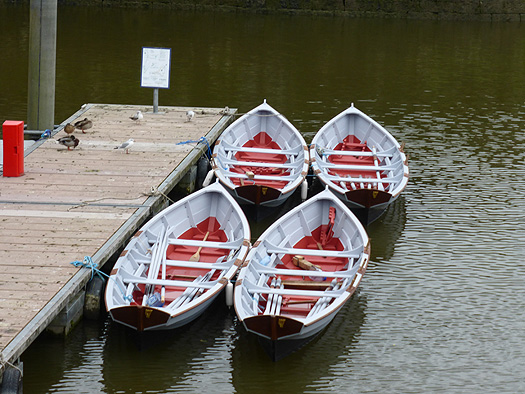
The elegant drawn-out transom of a gandelow.......Photo: W M Nixon
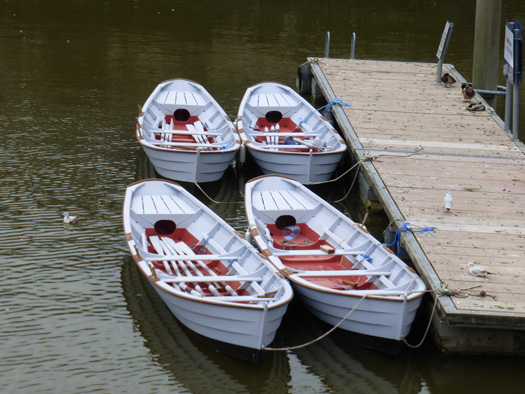
...contrasts markedly with the no-nonsense shape of the bow. Photo: W M Nixon
The real secret of the success of such a project is that once the boats are built, they must as more than interesting maritime objects. They have to be used, and used as much as possible, taken to different venues and rowed in active competition both for team building and the sheer sport of it all. The classic gandelow is rewarding to row. She's hefty enough, but with proper teamwork quite a respectable speed is possible, and the sport is good but as with any boat racing, skilled mark-rounding can be crucial to success, particularly so with these flat bottomed skid-pans which can slide sideways when you're trying to cut through on the inside curve.
As for locations, in 2014 alone the Gandelow Gang have been making the scene at the Battle of Clontarf re-enactment in April (after all, the original winner Brian Boru was a Limerick man, even if he was killed at the end of it). Then in late April they were in Venice. Just like that. For where else in Europe would you feel obliged to take a gandelow?

Getting afloat in Venice, Limerick style. The Gandelow gang had to make their own launching arrangements when they arrived in the Serenissima.....
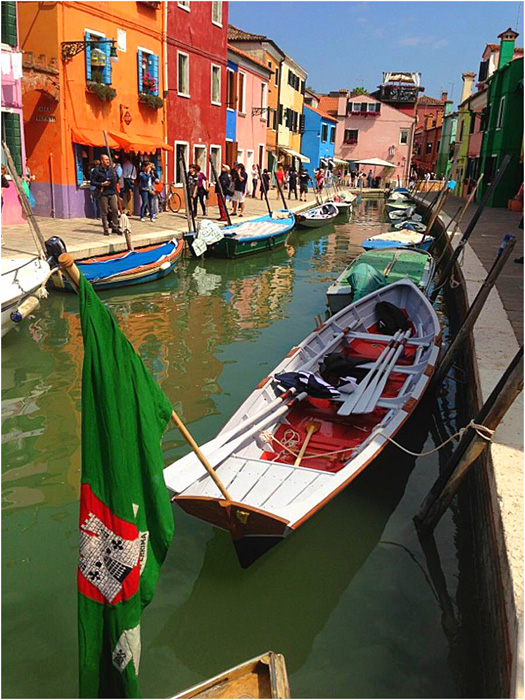
.....but once established in Venice, they were soon part of the scene
When Limerick folk decide to up and go from their homely city, they get on and do it, and though they were co-ordinating with the Serenissima's Master of Waterborne Ceremonies in Venice, they did many things their own no-nonsense way. And as for how a squad of ordinary Limerick people can afford a six-day stay in one of the most expensive cities in the world, the word is they sussed out a convent right at the heart of things where deserving guests can stay for €25 per night.

The Baltimore Wooden Boat Festival in May provided another showcase for the gandelows. Seen here rowing their classic Limerick boat towards the gaff ketch Sile a Do are Liam O'Donoghue, Anthony Kenny and Robert Smalle
For the gandelows back from Venice, in addition to races at home, 2014 continued with the Baltimore Wooden Boat festival at the end of May, the Lough Scur Midsummer Festival in June, and the Ballydehob Gathering of the Boats in August (see this blog September 6th). This would be enough for most of us to be getting along with, but back in the Ilen base in Limerick another project was rapidly taking shape, the CityOne sailing dinghies.
Inner city interest in small boats in Limerick had been aroused by the gandelows, so the building of a class of sailing dinghies was seen as adding a logical new element. But while some people thought something like a GP 14 or the heftier Wayfarer might best fill the bill, this was to miss the point of the Ilen experience entirely. To work, the boats had to be built in Limerick in the first place, and be to a unique design.
If this sounds a bit crazy, look at it as the small boat version of craft beers. Just about every town and village in Ireland now has its own craft brewery, and they cater for a thriving home and export trade for public tastes jaded by standardization and centralization. The making of the beers is as much part of the interest as their tasting and consumption. Equally so is the Ilen School philosophy for boats. The new CityOne dinghies were to be built from scratch, and their team-led construction, by people from every walk of life who had found a worthwhile interest in building small boats, would be vital to the success of the project.

Gary MacMahon (left) with Theo Rye, designer of the CityOne. Photo: W M Nixon
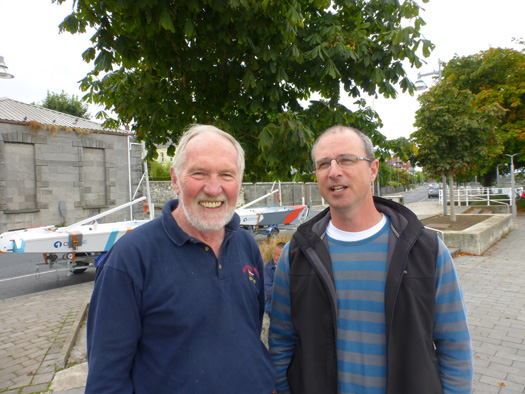
Hal Sisk (left) assembled a team to publish the G L Watson book, and from that Theo Rye (right) became the designer of the CityOne. Photo: W M Nixon
Everything hung on finding the right design. But with typical MacMahon serendipity, the right man was brought in. Gary had been much involved in his work as a designer with Hals Sisk's Peggy Bawn Press in creating that masterful and massive volume, the copiously-illustrated "G L Watson, the Art & Science of Yacht Design" by Martin Black, a wonderful account of the story of the great Scottish yacht designer which has deservedly won international awards since its publication in 2011. And among the team of all the talents involved in its creation was naval architecture historian and innovative boat designer Theo Rye, who was soon absorbed by the challenge of creating a design for a sailing dinghy which would be rewarding to sail, yet could be built in Limerick in timber – mostly plywood – by enthusiasts many of whom had little or no skill in boatbuilding, or even elementary woodwork.
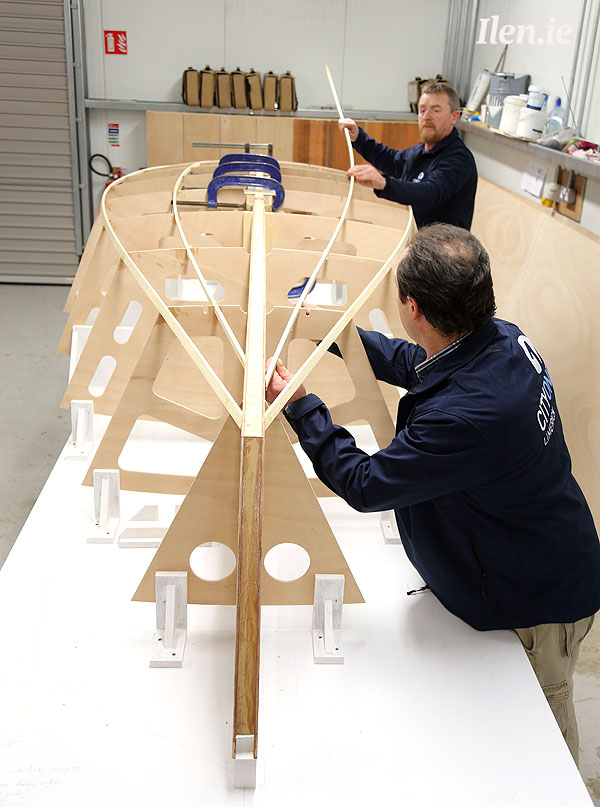
Early building stage of the first CityOne
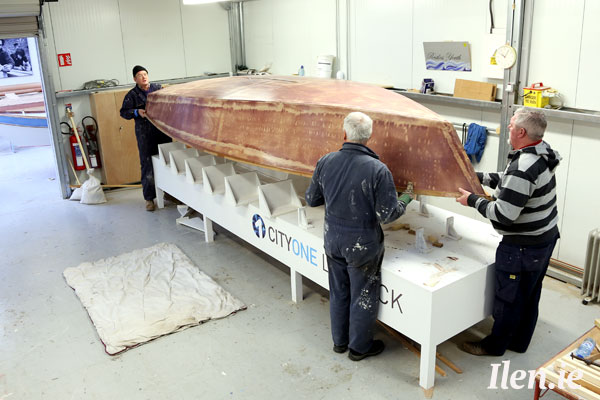
The basic hull is lifted clear........

....and the attractive wood engineering of the interior is completed.
The result is a basically simple flat-bottomed design but with some beautiful wood engineering, as you'd expect with Hal Sisk donning his other hat as an engineer to make input into the construction details. Yet overall the concept is one of attractive simplicity. To move on from this, the Ilen group organized an international graphic design competition for ideas for the colour schemes for the first four boats. They attracted 61 entries worldwide, and the four selected schemes were from Cale Funderburk of Texas, Andre Aguiar of Portugal, Kashyap Gohel of Kenya, and Con Ryan of Limerick.
We've had teaser photos on Afloat.ie in recent weeks showing the first of these hyper-colourful boats having their trial sails, but believe me folks, you ain't seen nothing until you've seen them all together, and that only became possible last Saturday morning as the last of the foursome had only had her final coat of paint on Friday night.
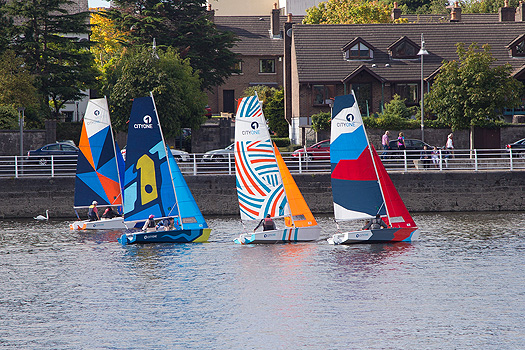
The first four CityOne dinghies racing together on the Shannon in the heart of Limerick on Saturday September 20th 2014 are decorated in the colour schemes created by (left to right) Con Ryan (Ireland), Kashyap Gohel (Kenya), Andre Aguiar (Portugal) and Cale Funderburk (Texas).
It was just in time, and what a time we had down on Shannonside in Limerick last Saturday, with the CityOne flotilla making their debut in the heart of town in a series of races masterminded by Geoff O'Donoghue of Lough Derg YC, while the gandelows staged a regatta in tandem with the sailing with some mighty oarsmanship.
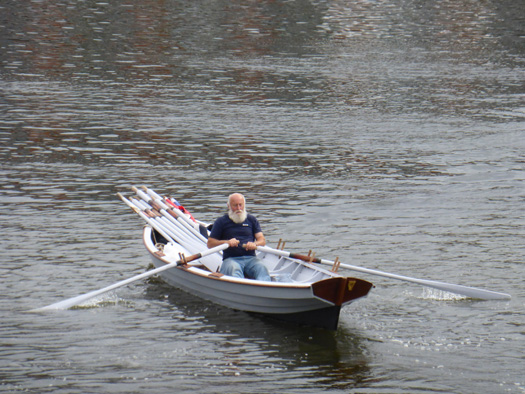
Off to the races. Gandelow stalwart Liam O'Donoghue rows across the river with oars and pennants ready to race. Photo: W M Nixon

Geoff O'Donoghue of Lough Derg YC calls the first start of the gandelow races, which got off to a slightly ragged beginning.......Photo: W M Nixon
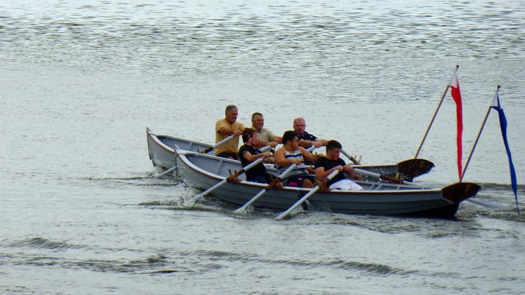
......but soon the crews were settling into their stride......Photo: W M Nixon

.......and by the finishes, the winning crews were setting a ferocious pace. Photo: W M Nixon
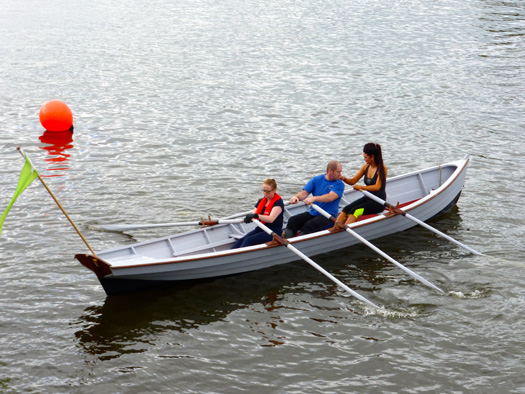
The Ladies Crews were allowed one man on board....Photo: W M Nixon

....but when it came to the racing, they were equally determined. Photo: W M Nixon
The sailing and rowing images which have resulted project a Limerick many people won't recognize from popular perceptions of that once-gritty town, but Limerick in its year as City of Culture is being re-born at astonishing speed. Thus the comfortable suburbs along the west side of the river provided an affluent, well-established and leafy background, but across on the east side, right in the heart of the old city's waterfront, the re-born Howley's Quay, with rugby legend Peter "The Claw" Clohessy's pub at the centre of it, provided an ideal regatta headquarters.
Pride of place in the Clohessy super-pub establishment is a completely re-vamped fine dining venue. As Gary MacMahon happened to be the design consultant on that, he persuaded the boss that it should be re-named The Gandelow Restaurant. So with the gandelows effecting their crew changes at the steps inside the new boardway right at the pub, all our ducks – and swans too – were neatly in a row to get a photo of a gandelow at The Gandelow.
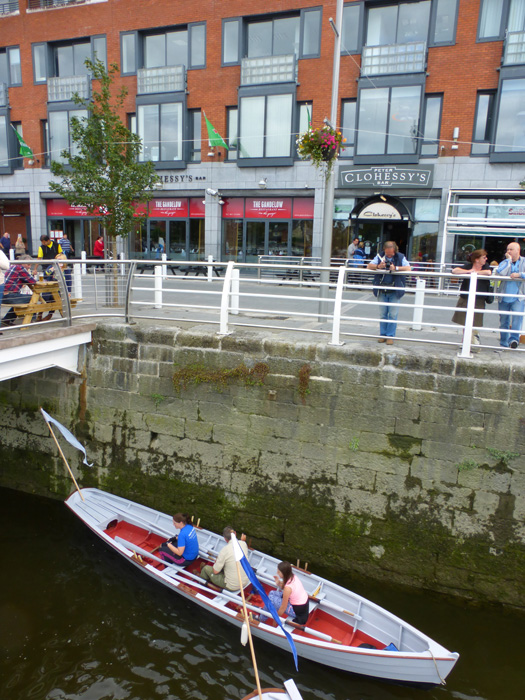
Peter Clohessy's famous bar-restaurant on Howley's Quay in Limerick provided an ideal regatta base......Photo: W M Nixon
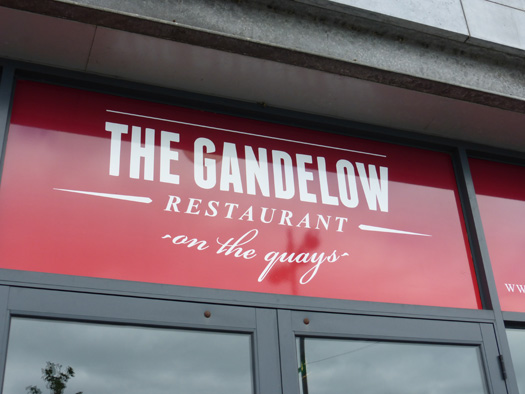
....and he in turn has re-named his fine dining venue in honour of the local traditional boats. Photo: W M Nixon
As to the CityOne racing, it was basically between teams from Culaun SC in Clare, Lough Derg YC, NUI Galway SC, two teams from Garrykennedy SC, Foynes YC, Killaloe SC, and the "Constructors Sailing Club" team which included Gary MacMahon, Theo Rye, Hal Sisk, and Steve Morris the talented New Zealand shipwright who led the building of the superb Sally O'Keeffe down in Kilrush (see this blog on May 10th), and whose guidance in the CityOne project was invaluable.
Many others were involved as RIBS were on hand to bring about crew changes and get as many people as possible, experienced and newcomers alike, out sailing in these remarkable little boats. But in the end, after working out a formula which only he fully understood, Geoff O'Donoghue declared that the winners were NUI Galway led by Cian Walsh.
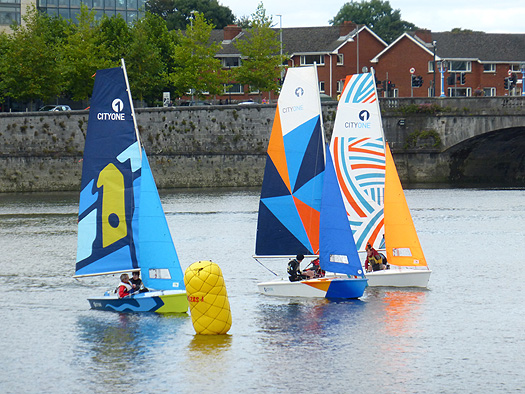
A dream comes true. New boats of the CityOne class sailing together in the heart of Limerick. Photo:W M Nixon

The Shannon in Limerick becomes busy towards high water. Two new boats of the CityOne class are in pre-start manouevres while crews are conveyed to other boats by RIB, and at the west bank a four-oared racing shell from St Michael's Rowing Club finds a clear passage upriver. Photo: W M Nixon
However, the complexity of the racing formula tested even the commentary skills of another of the Ilen team, Brother Anthony from Glenstal Abbey. But his real strength being words which emerge from a quiet study, his thoughts came clearly forefront yesterday, as it was he who thought of calling the current display of the CityOne boats in St Mary's the "Naumachia in the Cathedral".
In this blog in times past, we've outlined the difficulties of making sailing a spectator sport by referring to the experiences of Roman Emperors who occasionally flooded the Colosseum to stage naval battle re-enactments, but even they found these bloodthirsty shows prohibitively expensive. However, thanks to Brother Anthony's research we find that the ancient Greeks were there first, as they coined the phrase Naumachia to capture the flavour of an enclosed naval engagement in a stadium setting. Now, down in Limerick, they've revived it, but with entirely peaceful connotations for boats on harmonious display in a cathedral.
That said, there was once something of a battle in St Mary's Cathedral, and it brings our story full circle by noting that it involved Conor O'Brien of Saoirse fame. Though he didn't practice very much as an architect, one job he took on shortly before leaving on the great voyage of the Saoirse was the design of a screen for St Mary's commissioned by the Glentworth family.
It had been mostly completed in the workshop before he departed in June 1923, but it wasn't installed until he was thousands of miles away in the midst of his voyage. They managed to put it in back-to-front. And it was only O'Brien himself who noticed his on his return. He was a man with a notoriously short fuse. It boggles the mind to imagine the scene.
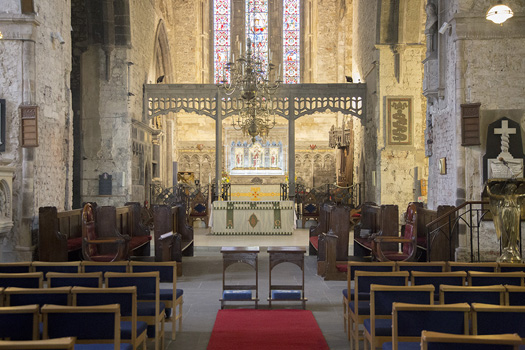
The Glentworth Screen in St Mary's Cathedral in Limerick was originally installed back-to-front while its architect Conor O'Brien was away on his famous voyage around the world in Saoirse..
But now, with the Glentworth Screen the right way round, all is sweetness and light in St Mary's Cathedral for the boats of the Ilen school. Michael Noonan TD launched the exhibition yesterday. President Michael D Higgins will be there on Monday afternoon. And as the boats are in the Cathedral for another two weeks , it's well worth seeing for a project which has helped to give unexpected added meaning to Limerick's role as City of Culture.
For as Minister Noonan put it at his launching of the exhibition: "I have always had the notion that the divisions between art and craft were too separate in Ireland, and that not enough credit was given to people that can do things with their hands, and are truly expert in their craft. There is a much wider concept where the artists and craftsmen come together and you get an integrated culture, and we can all celebrate that coming together here today".

Sea and city intertwine. The new boardwalk bridge at the Howley's Quay Steps was ideal as a viewing platform, while the steps greatly aided crew changes for the gandelows. Photo: W M Nixon
Shannon Wave Surfing Could Be The Next Big Thing
#Surfing - First the Dutch are pioneering canal surfing - and now some intrepid Irish surfers are in on the act, proposing a river wave on the Shannon as the next big surfing hotspot.
The Limerick Leader reports on UL student Paul Deering and his friend Kalani Moore who have demonstrated the potential of the standing wave at Curragower Falls for more than the usual canoe paddlers.
“It could potentially attract surfers from all over the world,” said Deering, making reference to a similar wave on the Esibach in Munich, Germany that's been a focal point for European surfers since the 1970s.
The Limerick Leader has more on the story HERE.





























